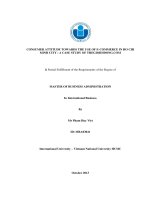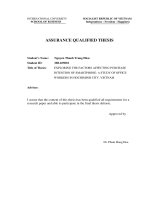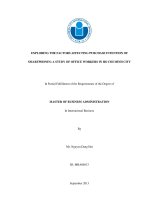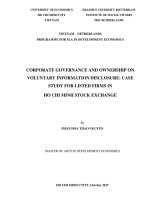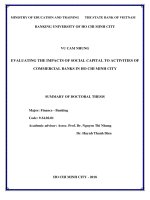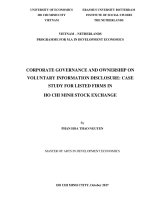Explore the perception of walkable city a case study of young generation in ho chi minh city
Bạn đang xem bản rút gọn của tài liệu. Xem và tải ngay bản đầy đủ của tài liệu tại đây (3.21 MB, 71 trang )
NGUYEN TAT THANH UNIVERSITY
FACULTY OF BUSINESS ADMINISTRATION
NGUYEN TAT THANH
GRADUATION THESIS
TOPIC:
EXPLORE THE PERCEPTION OF WALKABLE CITY: A
CASE STUDY OF YOUNG GENERATION IN HO CHI
MINH CITY
Supervisor:
Student’s name:
MBA. VO VUONG BACH
DANG DINH MINH
ID:
Class:
HCM City - 2023
2000000055
20DQT1C
NGUYEN TAT THANH UNIVERSITY
FACULTY OF BUSINESS ADMINISTRATION
NGUYEN TAT THANH
GRADUATION THESIS
TOPIC:
EXPLORE THE PERCEPTION OF WALKABLE CITY: A
CASE STUDY OF YOUNG GENERATION IN HO CHI
MINH CITY
Supervisor:
Student’s name:
MBA. VO VUONG BACH
DANG DINH MINH
ID:
Class:
HCM City - 2023
2000000055
20DQT1C
COURSE INSTRUCTOR’S EVALUATION
Total score:.............................
..............., September 2023
SUPERVISOR
1
ACKNOWLEDGEMENT
I wish to pay my deepest gratitude and respect to my supervisor, Mr. Vo
Vuong Bach, for guiding and supporting me throughout the process of making this
thesis.
I also would like to thank my friends, family, and all the interviewees for
participating in my research. Without them, this thesis would not have been
possible.
Ho Chi Minh City, September 2023
Dang Dinh Minh
ii
TABLE OF CONTENTS
COURSE INSTRUCTOR’S EVALUATION.................................................... I
ACKNOWLEDGEMENT .................................................................................. II
TABLE OF CONTENTS.................................................................................. Ill
LIST OF ABBREVIATIONS...........................................................................VI
LIST OF FIGURES..........................................................................................VII
LIST OF TABLES.......................................................................................... VIII
CHAPTER 1: INTRODUCTION..................................................................... 1
1.1 Background................................................................................................ 1
1.2 What has already been done on this issue................................................ 1
1.3 Objectives................................................................................................... 2
1.4 Thesis structure.........................................................................................2
CHAPTER 2: LITERATURE REVIEW......................................................... 3
2.1 Walkability definition................................................................................. 3
2.2 Walkable cities - what are they?............................................................... 3
2.3 Characteristics of a walkable city............................................................. 3
2.4 Student’s awareness.................................................................................. 8
2.5 Why walkable cities are important............................................................ 8
2.5.1 Why people today don’t walk more........................................................ 8
2.5.2 Urban sprawl and Car dependence culture............................................ 9
2.5.3 Negative effects of bad urban planning and design............................ 10
2.6 Benefits of walkable cities....................................................................... 21
2.6.1 Health benefits..........................................................................................21
iii
2.6.2 Economic benefits.................................................................................... 23
2.6.3 Livability benefits..................................................................................... 28
2.6.4 Social benefits...........................................................................................29
2.6.5 Environmental benefits............................................................................ 32
2.6.6 A walkable city is a sustainable city..................................................... 33
2.6.7 Drivers of change..................................................................................... 35
CHAPTER 3: METHODOLOGY.................................................................. 37
3.1 Methods...................................................................................................37
3.2 Data collection......................................................................................... 37
3.3 Data analysis...........................................................................................37
3.4 Questionnaire design............................................................................... 38
3.5 Sampling interview................................................................................. 38
3.6 Recruitment.............................................................................................. 38
3.7 Conducting interview.............................................................................. 39
3.8 Things I did to make the interviews more effective................................ 40
CHAPTER 4: RESULTS AND DISCUSSION.............................................42
4.1 . Result.................................................................................................... 42
4.1.1 Perception of walkable city................................................................... 42
4.1.2 Perception of walkable city benefits.................................................... 44
4.1.3 Perception offlaws and setbacks.......................................................... 46
4.1.4 Attitude and support toward walkable city......................................... 46
4.2 Discussion............................................................................................... 4 7
CHAPTER 5: CONCLUSION........................................................................49
5.1 Practically implementations................................................................... 49
iv
5.2 Lesson from Singapore and Seoul.......................................................... 50
REFERENCES................................................................................................... 51
APPENDIX 1
0
APPENDIX 2
0
V
LIST OF ABBREVIATIONS
AAA
American Automobile Association
CDC
The Centers for Disease Control and Prevention
CTA
Chicago Transit Authority
DESA
United Nations Department of Economic and Social Affairs
FDI
Foreign Direct hlvestment
GDP
Gross Domestic Product
GNP
Gross National Product
HCMƯT
Ho Chi Minh City University of Technology
MTA
Metropolitan Transportation Authority
ƯHI
The Urban Heat Island
NACTO
National Association of City Transportation Offcials.
NTTU
Nguyen tat thanh university
RMIT
Royal Melbourne Institute of Technology
TOD
Transit-Oriented Development
WHO
The World Health Organization
vi
LIST OF FIGURES
Figure 2-1. Downtown Houston, Texas, 1970s....................................................... 13
Figure 2-2. Truman Sports Complex, Kansas City, Missouri................................14
Figure 2-3. Source: The cost of parking.................................................................. 14
Figure 2-4. Source: Global Street Design, NACTO.............................................. 15
Figure 2-5. Global CO2 emissions from transport, 2018.......................................16
Figure 2-6. Urban sprawl and mono functional area, Jeff Peck............................ 17
Figure 2-7. The loneliness epidemic is a search term............................................ 18
Figure 2-8. The relationship between speed and stopping distance..................... 20
Figure 2- 9. Drives’ visual focus diminishes as speed increases............................ 20
Figure 2-10. Hourly capacity of a 3 m-wide lane by different modes at peak
conditions. Source: Global Street Design..................................................................26
Figure 2-11. Source: U.S Department of Transportation......................................27
Figure 2 - 12. Japanese traditional Starbucks’ exterior and interior....................... 32
Figure 2-13. Global population size and annual growth rate. World Population
Prospects - 2022........................................................................................................... 35
vii
LIST OF TABLES
Table 2-1. Walkable city characteristics.................................................................... 7
Table 2-2. Sustainable Cities International’s Indicators for Sustainability list. .34
Table 3-1. Participants and Interview’s information............................................ 39
viii
CHAPTER 1: INTRODUCTION
1.1 Background
The goal that all governments and city planners should strive for is to build
cities more inclusive, safe, resilient, and sustainable. As of 2023, half of humanity,
4 billion people, live in cities. Even though the birth rate has slowed down, the rate
of urbanization has not. It is estimated that by 2050, two out of every three people
are likely to be living in cities or other urban centers, according to a new United
Nations report. As more and more people keep moving to cities in search of jobs,
education, and a better quality of life, the problem of sustainability begins to
emerge. “Many countries will face challenges in meeting the needs of their
growing urban populations, includingfor housing, transportation, energy systems,
and other infrastructure; as well as for employment and basic services such as
education and health care,” said the United Nations Department of Economic and
Social Affairs (DESA).
People are beginning to realize the effects of bad urban plaiming and design,
not only for themselves but the environment they live in. The rapid development
of urban areas has led to numerous issues like congestion, polluted air, carbon
emissions, high housing costs, and widening inequality. Cities are also the major
contributors to the global warming. Cities occupy just 3% of the Earth’s surface
land area but account for 60-80% of energy consumption and 75% of carbon
emissions (Jane Jacobs, 1992). Among those who are affected are GenZ and
Millenials. They are currently fighting the rising cost of housing, and living, much
greater than previous generations. GenZ and Millennials also have to face the
effect of climate change to a greater extent, all while coping with the highest level
of loneliness seen in any generation. All of these factors and changes will impact
the future city designs and thus, in turn, force people and businesses to adapt.
1.2 What has already been done on this issue
Walkable cities, walkability, and other related issues have been extensively
researched ever since the 1970s. This model is a response to American urban
1
planning after WW2, specifically the urban sprawl and car dependency culture.
Today, a walkable city is a part of a movement to help reduce the impact of bad
urban planning on the environment, the economy, and the lives of the people within
it. A walkable city shared more than just a few attributes of a sustainable city.
hl researching this subject, the author found that there are a lot of books, and
research papers written regarding this issue by authors from all over the world.
However, there is little information on this issue available in Vietnamese. The term
walkable city is not familiar to many Vietnamese people. If you type “walkable
city” into the Google search bar, the closest answer you’ll get is the walkable street.
So, it is obvious that this is not a common topic of conversation among
Vietnamese. Of course, there are few research written by Vietnamese researchers
that discuss this issue, but of course, they are all written in English, and none of
them focus on college students' awareness of the issue.
1.3 Objectives
Research question: What are the young generations' perceptions of walkable
cities?
Research objectives:
Explore young people's perception of a walkable city, its benefits, flaws
and setbacks, and their attitude toward it.
How businesses should adapt according to the new demographic trends.
Research method: This study uses in-depth interviews to collect data and
deductive coding to analyze data.
1.4 Thesis structure
The remainder of this study is structured as follows: Chapter 2 present a
literature review of walkability, walkable city, its characteristics, and benefits;
Chapter 3 methodology that the author has used; Chapter 4 discuss the results and
provide suggestion to improve awareness among college student; finally, Chapter
5 will provide some practical implementations and conclude the study.
2
CHAPTER 2: LITERATURE REVIEW
2.1 Walkability definition
The term ‘walkability’ was first coined by Jane Jacobs, in her book The Life
and Death of Great American Cities in the 60s. Since then, there have been a lot
of definitions for the walkable city, however, there are 2 that simplify it best:
Walkability is the extent to which the built environment supports and
encourages walking by providing pedestrian comfort and safety’, connecting people
with varied destinations within a reasonable amount of time and effort, and
offering visual interest in journeys throughout the network (Southworth, 2008).
Walkability is “the extent to which the built environment is friendly to the
presence ofpeople walking, living, shopping, visiting, enjoying or spending time
in an area" (Burden, 2010).
2.2 Walkable cities - what are they?
hl summary, a walkable city is a city where:
Walking is a default mode of transportation for everyone, regardless of
age, income, and ability.
Enable people to travel from where they currently are to where they
need to be without the need for a personal vehicle. Personal vehicles are still
allowed to coexist, but unnecessary.
The entire city is designed and planned out so that it would best serve
people’s mobility and improve their quality of life, i.e. adequate PT system,
amenities are equally spread and easy to access.
-
A walkable city has many elements of a sustainable city.
2.3 Characteristics of a walkable city
To better understand it, we need to explore the characteristics of a walkable
city:
Human-centric
Pedestrian first
hl a walkable city, pedestrians are given priority over motorists.
Motor vehicle speed and numbers are reduced and, in some
areas, banned entirely, commonly also known as Car-free city.
3
The city has a human-scale design, with block lengths and
building sizes tightly regulated.
Street has many facilities that allow pedestrians to stop, stay,
and spend time like parks, plazas, and small parks.
In a walkable city, being able to freely travel, access, and enjoy
the city is recognized as a basic human right. To that end, a city
must promote diversity, equality, and inclusivity.
Diversity in this context doesn’t necessarily mean race,
Equality
Inclusivity
ethnicity, or religion, but rather age, income, and occupation.
Inclusive toward those with disabilities (vision or hearing
impairments, wheelchairs, and cane users).
Diversity
Meanwhile, Equality means providing social mobility, i.e. the
opportunity to move around, to access the city’s services and
amenities, to find jobs, and to build a better life.
hl short, a walkable city should provide the same opportunity
for everyone and not discriminate against any targeted group.
A walkable city allows everyone easy access to schools,
hospitals, offices, shops, parks, libraries, outdoor coffees, and
public spaces like town squares, and parklets.
Accessibility
This is archived through Transit-Oriented Development
(TOD). By providing many alternative modes of transpoiiation
like bus, bicycle, train, subway, walking and spacing them
within 10-20 min of where people are. (This is also called the
15-minute city).
The streets of the city must be linked continuously, allowing
Continuity
people to travel everywhere within the city unobstructed. This
means providing many alternative routes, if one path is closed
Connectivity
for maintenance, others should still be available. At the same
time minimize dead-end streets and cul-de-sacs.
4
For a city to be walkable, it must have things that attract people,
i.e. a reason for them to walk. Cities should be places people
want to be in, not just pass by quickly hl the theory of “walk
Aesthetics
appeal,” Steve Monzon argues that how far people will walk
Attractiveness
depends on what they encounter along the way. This could be
Visually
walkable public spaces, beautiful city squares, attractive
Interesting
architecture, historical buildings, landmarks, and public arts.
Mystery alleys and building design also add to the city a sense
of mystery and intrigue, which provokes curiosity and compels
visitors to explore them.
Comfortable means clean air, low noise level, sidewalks are
Comfortable
wide enough to accommodate a large number of people, and
Pleasantness
clean with good quality pavements and furniture. Protecting
Enjoyable
people
from
harsh
weather
and
motorists.
Reduce
encroachments into the pedestrian right-of-way.
Safety means that pedestrians should be protected from
motorized traffic, while security means that pedestrians should
be protected from crime and incivilities.
The city must provide the people with safety, or the perception
of safety, from crime, and accidents both in the morning and at
night. The feeling unsafe negatively impacts people’s
Safety
Security
willingness to walk.
Adequate light can help make people feel safer and increase
nighttime activities.
Traffic calming measures to slow driving speeds and reduce
traffic volumes like chokers, chicanes, speed bumps, raised
crosswalks, narrowed streets, rough paving, traffic diverters,
roundabouts, and landscaping; Physical separation from
fastmoving cars, or buffers, include curb extensions, parklets,
5
stormwater management features, parking, cycle racks, cycle
share stations, and curbside cycle tracks; Adequate time and
signalization protection when crossing intersections
The city as a whole is built to assist people to move around.
Convenient
This could be benches, public toilets, signs and pathfinders. An
example is the rams built to aid wheelchair users.
Mix land use/
Instead of separating the places where people live, work, and
Mixed zoning
entertain. A walkable city mixes these functions so that the
High-density/
travel distance is reduced dramatically.
Compact
hl urban sprawl design, a house is just for living, called single
Mixed-use
family residential, hl a walkable city, houses usually have
buildings
mixed functions. People can live on the upper floors and do
business on the bottom as seen in many Asian cities, and towns.
Cities should not look identical to one another. Rather, there
should be a variety of buildings; shapes, sizes, materials, and
Distinctiveness
colors. Each city can enhance its identity by embracing its
architectural styles.
Urban streets need to accommodate a variety of speeds.
Depending on age and ability, people will walk at different
speeds. Typically, walking speeds range from 0.3 m/s-1.75 m/s
Variety
or 1 km/h-6 km/h.
Walkable streets must designed to accommodate a variety of
transportation modes.
Cities are meant to promote social interaction, therefore, one of
the main tasks is to foster a sense of belonging and social
Sociability
cohesion. This can be done by allowing for a range of
experiences and community activities that help people form
connections, like festivals, parades, etc.
6
Transparency is the extent to which the pedestrian environment
is obvious, clear, and/or transparent, i.e. the degree to which
Conspicuous
people can see or perceive human activity beyond the edge of
Visibility
a street makes a pedestrian environment more attractive. This
Transparency
is archived through widows, outdoor displays, and sidewalk
cafes. A transparent environment allows one to sense the social
and natural life of a place through first-hand observation.
Vibrant is the degree to which varied applications of shop
front/housing materials, design, color, and decor add interest to
Vibrant
Activated
the pedestrian experience.
Activating main streets, where people can gather and interact
(e.g., pedestrian pocket parks and plazas) helps foster a sense
of visually active frontages.
Sense of place
Community
A walkable city fosters a sense of place, which helps people
and visitors form an emotional attachment to it.
The city also strives to preserve and
strengthen the
focus
community’s heritage.
Streets are clean and well-maintained, clear of garbage, litter,
Clean
broken glass, or graffiti. Have an adequate number of garbage
bins.
Sustainable
A walkable city must be a sustainable city.
According to the Global Walkability Index 2006, policy
support refers to the commitment and support of local
authorities
through funding and
resources
devoted
to
Policy support
pedestrians and PT; Existence and enforcement of relevant
pedestrian safety laws and regulations; Degree of public
outreach for pedestrian and driving safety and etiquette.
Table 2-1. Walkable city characteristics
7
2.4 Student’s awareness
According to a study done by Siti Rechal (2019), awareness can be explained
as understanding something that happens around US. awareness can be used to
know someone’s perception of what they feel or understand in some aspects.
Awareness is divided into some cases; social awareness, culture awareness, self-
awareness, health awareness, and leadership awareness.
2.5 Why walkable cities are important
2.5.1 Why people today don’t walk more
Walking is the best possible exercise. Habituate yourself to walk very far. Thomas Jefferson (August 19, 1785, in a letter to Peter Carr).
Walking is the oldest and most basic form of transportation. Before the age
of the automobile, people simply walked to get to where they needed to be. It is an
enjoyable, sustainable, and healthy mode of transportation. There were also horses,
wagons, rail, and of course, bicycles. People walk for all kinds of reasons, Some
walk To school, to work, To shopping, to meet friends, to recreation, or just simply
to enjoy walking.
Walking also provides many benefits to people and the city as it is the most
environmentally friendly, costs next to nothing, and provides basic and natural
daily exercise needed to keep people healthy and in shape. The overall
environmental and health benefits of walking have been extensively analyzed and
discussed in literature over the years (Fernando Fonseca, et al., 2022).
Even though walking is the most fundamental form of human activity, in the
21 st century, people no longer consider walking as a natural form of transportation.
Rather, most people just choose to drive whenever they to go somewhere, hl his
book Exercised the Science of Physical Activity, rest and Health, professor of
human evolutionary biology Daniel Lieberman stated: The average hunter-gather
takes 10-15000 steps a day, an average American pre pandemic take 4700 steps a
day...20% Americans take the necessary the amount recommended by health
organization-150 minutes per week. He reasons that we have created a world where
exercise has become a choice, and a person in today's world has to make a
8
conscious choice to go to the gym and get exercise. The situation is most clearly
observed in developed Western countries like America, where car-dependence
culture has heavily affected how people travel and their health. This means walking
is the only activity left to give them some sort of daily exercise. But walking has
been mitigating in today's society. Why? Because driving is considered to be more
convenient.
2.5.2 Urban sprawl and Car dependence culture
“Ifyou plan cities for cars and traffic, you get cars and traffic. Ifyou plan
for people and places, you get people and places. ” - Fred Kent, Project for Public
Space.
The 20th century was undoubtedly the century of automobiles. Thanks to
industrialization, cars, and motorbikes have become more and more affordable,
leading to an explosion in their numbers across the globe. Mass-produced car has
revolutionized the way people move about in cities which led to their domination
in cities. As of 2022, there are about 290 million cars in the US, with a population
of 338 million. A similar situation is in Vietnam, where there are over 67 million
motorcycles in a population of 98.5 million. This means that everyone who can
own a vehicle does own one.
As more and more people begin to rely on the convenience of driving,
developed cities all over the world have changed in response to it, they began to
transform to accommodate the newly increased number of vehicles. Having a car
became a “must” for people in these cities. Not only does owning a private car
define an individual’s socioeconomic status, but the degree of car ownership plays
a role in defining the status of an economically advanced city (Simon Ng, 2012).
Even though no one can deny their usefulness, they nevertheless result in an
unintended effect, a city design and planning called urban sprawl, typically seen
in American suburbs. Sprawl is low-density residential housing with single-use
zoning, abundant free parking, with lots of cul-de-sacs, and resides dozens of miles
from the city’s center. Urban sprawl began with the expansion of cities into rural
areas and accelerated greatly during the last half of the 20th century. Urban Sprawl
9
is widespread in the 21st century, as approximately half of Americans expected to
live in suburbs. The resulting environments tend to be car-oriented and out of
human scale (Duy Thinh Do, 2018). Separating where people live and work,
increases the distance people need to travel every day. This creates a car
dependency culture, where cities are designed solely to accommodate driving,
meaning that people who live in these cities are forced to drive to get places. This
makes driving a car the default transport mode of residents, especially when public
transport is poorly provided (Simon Ng, 2012). This ultimately results in a city
with lots of highways cutting right through the city, depriving those who live in it
from walking, making driving their only choice. Urban density and urban sprawl,
hl short, these types of cities are no longer built for humans, but instead, for cars.
Which led to a large number of issues regarding climate change, livability, health,
and socioeconomic. Over time, people started to realize the negative effects of a
car-oriented city on their city and their lives.
2.5.3 Negative effects of bad urban planning and design
Winston Churchill once said of architecture, “We shape our buildings and
thereafter they shape us". What that means is: that the way we build our cities
affects the way we live and travel within them.
Impact on Health
Automobiles allow people to be more independent when it comes to travel.
However, it is also associated with many health hazards, including air pollution,
motor vehicle crashes, and pedestrian injuries and fatalities (Susan Claris, 2016).
Inactive population
Physical inactivity is the cause of most chronic diseases according to The
World Health Organization. An estimated 3.2 million people die each year due to
inactivity, making it the fourth leading factor of mortality.
Obesity epidemic
According to a 2016 WHO report, an estimated 13% of adults (1.9 billion
people) aged 18 years and older are overweight globally, and over 650 million of
those are obese, hl the United States, it is estimated that over two-thirds of the
10
